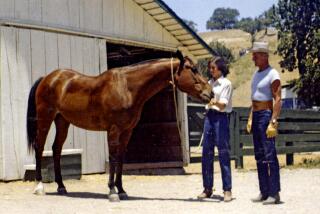Iconic book, iconic film: reappraising ‘GWTW’
“Gone With the Wind” -- a book in 1936 and then a movie in 1939 -- was above all a phenomenon. To this day, the Civil War epic romance remains the most successful blockbuster ever. As film critic Molly Haskell sees it in her slender reappraisal, “Frankly, My Dear: ‘Gone With the Wind’ Revisited,” it is also a conflicting icon in American culture.
Haskell, who grew up in Virginia, divulges a curious fact about the fiction: Her great-great-grandfather was Wade Hampton, the South Carolina general, and later governor, after whom author Margaret Mitchell named Scarlett O’Hara’s first child (in the book -- he didn’t make it to the screen).
The author of “From Reverence to Rape,” an early feminist examination of women in the movies, first published in 1974, Haskell has not written a memoir, but her book is marked as much by personal feeling as it is by critical assessment.
In looking at the making of the film, Haskell focuses on producer David O. Selznick. A man who lived on Dexedrine, peanuts and bananas, he went through three directors (George Cukor, Sam Wood and the ultimately credited Victor Fleming). His appetite for screenwriters was even more voracious, including Sidney Howard, Ben Hecht and F. Scott Fitzgerald, to name only a few.
But his mania paid off, as did his machinations to snatch Clark Gable, who was under contract to MGM, and his public relations ploy to enlist the book’s legion of fans in the search for the perfect Scarlett.
“Casting is part of the writing,” Haskell notes, and her account of the process is particularly enjoyable, with meditations on the “ocular intensity” of Bette Davis, the unexpected parallels between Yankee Katharine Hepburn and Southern minx Scarlett and the difficulty of detecting potential stardom in screen tests.
Then there is the “discovery” of Vivien Leigh for whom “Gone With the Wind” was “both the glorious peak and the beginning of the end of her movie career.”
All this, though, is a warm-up for the core of the book, which is Haskell’s chapter on Mitchell, her manipulative heroine, Scarlett, and the transgressions the two perpetrated against received ideas of sexuality and gender.
Underneath those magnolias and hoop skirts, Scarlett is a female subversive, “a predator who marries three men she doesn’t love,” “a rotten mother” and “a successful business woman.” But the real marvel is how little she pays for her misdeeds.
Standard punishment, Haskell notes, would entail “one or more of the following: sexual and psychological humiliation, a barrage of self-satisfied diatribes and blandishments from the people she’s wounded; death, or, in its stead, an eleventh-hour reversal whereby she repents her wicked ways, is brought back to heel, and is transformed by love into a submissive female.”
Haskell traces Scarlett’s origins to Mitchell’s own life. It’s a fascinating character study. As a young girl growing up in Atlanta, Mitchell chafed against her mother’s rigid sense of decorum and for a time renamed herself Jimmy.
She appalled gossip columnists and society matrons by performing the “notorious Apache dance” at a debutante ball and was promptly dropped from the Junior League. (Mitchell got her revenge when “Gone With the Wind” premiered and she refused to attend the Junior League’s party.)
And yet, as Haskell astutely notes, Mitchell “might act out her rebellion against upper-crust society, but she was not about to sacrifice its privileges.” These paradoxes, these tensions between “vulgarity and refinement,” are what Haskell sees in Selznick and Leigh also, and she persuasively argues that they give “Gone With the Wind” its power.
Along with Gable. Haskell speaks eloquently to the particular mix of virility and vulnerability that he brought to the role of Rhett Butler.
Early in “Frankly, My Dear,” Haskell calls out “Gone With the Wind’s” tactic of racist occlusion, of never raising the issue of slavery and its obvious relation to the Civil War. In the book’s closing chapter, she proposes some intriguing parallels, arguing that the star system of 1930s Hollywood was not dissimilar to the hierarchies of the Old South.
She questions both the romance of the Lost Cause that allowed white Southerners a consoling view of the past and the notion that Reconstruction was a time of unchecked corruption. She mentions Frederick Douglass and W.E.B. Du Bois, retraces Hattie McDaniel’s biography and sketches out Butterfly McQueen’s film career. Unfortunately, though, this section stands out for being a quick gloss.
Considering her own exposure to “Gone With the Wind” as a teenager and later as an adult, Haskell writes: “There’s a primary pull, then a recoil, a secondary period of shame at having been so thoroughly captivated.” While her examination of this primary pull is extremely vivid and fresh in her discussion of the key figures, what remains obscure is the recoil and attendant shame.
--
Brown has written for Bookforum, the London Review of Books and the New York Times Book Review.
More to Read
Sign up for our Book Club newsletter
Get the latest news, events and more from the Los Angeles Times Book Club, and help us get L.A. reading and talking.
You may occasionally receive promotional content from the Los Angeles Times.






